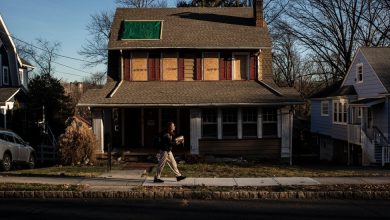London’s aging Hammersmith Bridge gets foil wrapping to protect it from rising temperatures.

LONDON — With temperatures soaring in London on Monday, the aging and crumbling Hammersmith Bridge, a Victorian-era suspension bridge over the River Thames that was already undergoing repairs, was wrapped in a protective foil to keep cracks in the metal bridge from expanding and threatening its stability.
The bridge, which was built in 1887, is currently closed to users other than pedestrians and cyclists after years of neglect. But the drastic temperatures of the heat wave created a new concern that small fractures in the cast-iron pedestals could widen and threaten the bridge’s stability.
The bridge had to be closed in August 2020 even to ships passing underneath, as temperatures soared and the cracks widened. It was reopened for pedestrians and cyclists, and for river traffic, in July last year. But according to Hammersmith and Fulham Council, the local authority responsible for the 135-year-old bridge, engineers are working “around the clock” to keep the bridge open.
Since 2020, a temperature control system costing 420,000 pounds (around $500,000) has been installed to keep the metal cool and to alleviate any stresses on the pedestals, the council said, acting as a “giant air conditioning unit on each of the four pedestal chains.”
The chains are anchored to the river bed and are regulated to be kept below 13 degrees Celsius (about 55 degrees Fahrenheit) in the summer. If they reach 18 Celsius, engineers will close the bridge, the council said. The brittle cast iron is especially sensitive to temperature fluctuations.
With the potential for unprecedented temperatures on Monday and Tuesday, engineers are running the cooling system through the night and have wrapped the portions of the chains that are above the water in reflective foil to protect them from the heat of the sun.
“As we deal with the current extreme heat, we are also coming up with innovative solutions to keep the temperature within the threshold,” Sebastian Springer, the project manager on the bridge works, said in a statement. But if the temperatures rise too high, the bridge will have to be closed, at least temporarily.
For those who use the bridge regularly, a full closure would cut off the already restricted connection between the Barnes, on the southern side, and Hammersmith, on the northern side, where many commuters head daily to reach the nearest Tube station.
D’Oliver Swaby, 41, a painter and decorator who was crossing the bridge Monday afternoon, said he wasn’t concerned about its stability because he felt high temperatures were the least of the issues.
“This bridge has been closed for years,” he said. “I just want to see it reopened properly for traffic, so I don’t have to always walk across.”
Mr. Swaby, who is originally from Jamaica, said the heat advisory hadn’t changed his plans for the day, and he wouldn’t be altering his routine on Tuesday, which is expected to be several degrees warmer. The heat didn’t bother him, he said, but the lack of respite from it in London could be a cause for concern. In Jamaica, he would take a dip in the sea or a river.
“But here, there is nowhere to cool off,” he said. “It’s so limited, and it’s so packed, there’s just so much concrete in the city.”
Ali Heydari, 75, and Soleh Heydari, 58, were resting in the shade on the north side of the bridge, eating strawberries and sharing a large bottle of water. They said that England’s lack of preparation for the heat sometimes felt laughable.
The pair, who are originally from Iran but who have lived in London for decades, said the heat didn’t bother them while they were outside, but they were avoiding buses and the Tube, where the temperature could become unbearable. They preferred to walk, even if that meant taking their chances on the corroded Hammersmith Bridge.
Still, Mr. Heydari said he was frustrated with the local government for not doing more to address the issue of the bridge’s instability sooner.
“They just don’t want to spend money to fix anything,” Mr. Heydari said.





